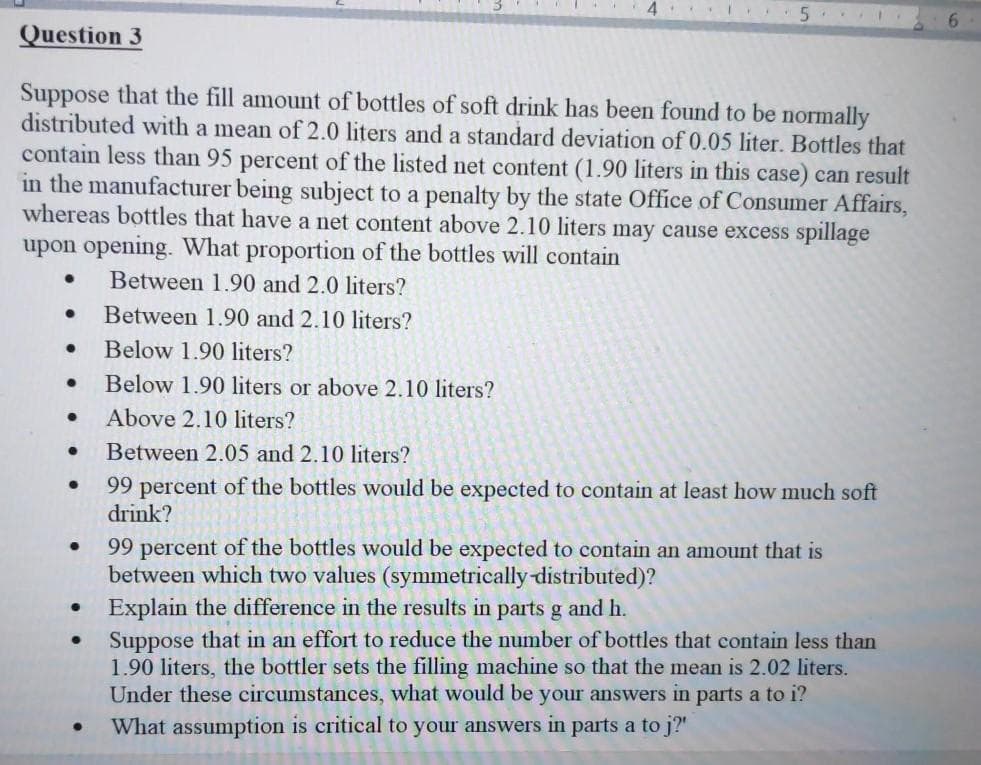Question 3 Suppose that the fill amount of bottles of soft drink has been found to be normally distributed with a mean of 2.0 liters and a standard deviation of 0.05 liter. Bottles that contain less than 95 percent of the listed net content (1.90 liters in this case) can result in the manufacturer being subject to a penalty by the state Office of Consumer Affairs, whereas bottles that have a net content above 2.10 liters may cause excess spillage upon opening. What proportion of the bottles will contain Between 1.90 and 2.0 liters? Between 1.90 and 2.10 liters? Below 1.90 liters? Below 1.90 liters or above 2.10 liters? Above 2.10 liters? Between 2.05 and 2.10 liters? 99 percent of the bottles would be expected to contain at least how much soft drink? 99 percent of the bottles would be expected to contain an amount that is between which two values (symmetrically distributed)? Explain the difference in the results in parts g and h. Suppose that in an effort to reduce the number of bottles that contain less than 1.90 liters, the bottler sets the filling machine so that the mean is 2.02 liters. Under these circumstances, what would be your answers in parts a to i? What assumption is critical to your answers in parts a to j?"
Question 3 Suppose that the fill amount of bottles of soft drink has been found to be normally distributed with a mean of 2.0 liters and a standard deviation of 0.05 liter. Bottles that contain less than 95 percent of the listed net content (1.90 liters in this case) can result in the manufacturer being subject to a penalty by the state Office of Consumer Affairs, whereas bottles that have a net content above 2.10 liters may cause excess spillage upon opening. What proportion of the bottles will contain Between 1.90 and 2.0 liters? Between 1.90 and 2.10 liters? Below 1.90 liters? Below 1.90 liters or above 2.10 liters? Above 2.10 liters? Between 2.05 and 2.10 liters? 99 percent of the bottles would be expected to contain at least how much soft drink? 99 percent of the bottles would be expected to contain an amount that is between which two values (symmetrically distributed)? Explain the difference in the results in parts g and h. Suppose that in an effort to reduce the number of bottles that contain less than 1.90 liters, the bottler sets the filling machine so that the mean is 2.02 liters. Under these circumstances, what would be your answers in parts a to i? What assumption is critical to your answers in parts a to j?"
Glencoe Algebra 1, Student Edition, 9780079039897, 0079039898, 2018
18th Edition
ISBN:9780079039897
Author:Carter
Publisher:Carter
Chapter10: Statistics
Section10.4: Distributions Of Data
Problem 19PFA
Related questions
Question
please answer.

Transcribed Image Text:Question 3
Suppose that the fill amount of bottles of soft drink has been found to be normally
distributed with a mean of 2.0 liters and a standard deviation of 0.05 liter. Bottles that
contain less than 95 percent of the listed net content (1.90 liters in this case) can result
in the manufacturer being subject to a penalty by the state Office of Consumer Affairs,
whereas bottles that have a net content above 2.10 liters may cause excess spillage
upon opening. What proportion of the bottles will contain
Between 1.90 and 2.0 liters?
Between 1.90 and 2.10 liters?
Below 1.90 liters?
Below 1.90 liters or above 2.10 liters?
Above 2.10 liters?
Between 2.05 and 2.10 liters?
99 percent of the bottles would be expected to contain at least how much soft
drink?
99 percent of the bottles would be expected to contain an amount that is
between which two values (symmetrically distributed)?
Explain the difference in the results in parts g and h.
Suppose that in an effort to reduce the number of bottles that contain less than
1.90 liters, the bottler sets the filling machine so that the mean is 2.02 liters.
Under these circumstances, what would be your answers in parts a to i?
What assumption is critical to your answers in parts a to j?"
Expert Solution
This question has been solved!
Explore an expertly crafted, step-by-step solution for a thorough understanding of key concepts.
This is a popular solution!
Trending now
This is a popular solution!
Step by step
Solved in 2 steps with 1 images

Knowledge Booster
Learn more about
Need a deep-dive on the concept behind this application? Look no further. Learn more about this topic, statistics and related others by exploring similar questions and additional content below.Recommended textbooks for you

Glencoe Algebra 1, Student Edition, 9780079039897…
Algebra
ISBN:
9780079039897
Author:
Carter
Publisher:
McGraw Hill

Glencoe Algebra 1, Student Edition, 9780079039897…
Algebra
ISBN:
9780079039897
Author:
Carter
Publisher:
McGraw Hill